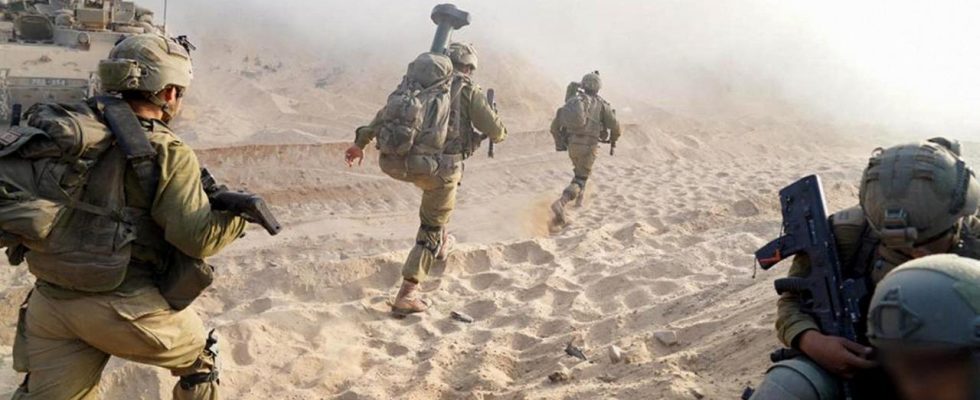Israeli Prime Minister Netanyahu raised questions with statements about the future of the Gaza Strip. An advisor has now made it clear what the head of government meant: An occupation of the area is not planned – but a military presence is.
Israel does not want to permanently occupy the Gaza Strip after the end of the war against Hamas, according to a senior adviser to Prime Minister Benjamin Netanyahu. But there must be a “security presence” by Israel so that the military can go in for operations depending on the threat situation, Mark Regev clarified on the US broadcaster CNN a statement by Netanyahu about Israel’s future role in the Gaza Strip the day before.
“We have to distinguish between security presence and political control,” Regev said. “When this is over and we have defeated Hamas, it is critical that there is no resurgent terrorist element there, no resurgent Hamas.” It doesn’t make sense to carry out the military offensive against Hamas “and just start over again.”
Fuss over Netanyahu interview
Netanyahu said in an interview with US broadcaster ABC on Monday that Israel wanted to assume responsibility for security in the Gaza Strip “for an indefinite period” in order to prevent further attacks. However, his words raised questions about what exactly Israel was planning.
Israel’s Strategic Affairs Minister Ron Dermer said Netanyahu “didn’t talk about occupying Gaza.” After the Islamist Hamas is “no longer in power” and its “infrastructure is destroyed,” Israel will bear “general responsibility for security for an indefinite period of time,” he said in an interview with the US television station MSNBC. If a “Palestinian force” governs Gaza “for the benefit of its residents and without wanting to destroy Israel,” it can be discussed. When asked how this could be done specifically, Dermer said that this was an open question. But it will “not be an occupation.”
USA against occupation
Meanwhile, the USA once again spoke out against Israel’s long-term occupation of the Gaza Strip. Israel doesn’t want that either, said US State Department spokesman Vedant Patel. “We believe that Palestinians must be at the forefront of these decisions and that the Gaza Strip is and will remain Palestinian land.”
John Kirby, communications director for the US National Security Council, reiterated his administration’s stance: “The President (Joe Biden) continues to think that a reoccupation of the Gaza Strip by Israeli forces is not good. It is not good for Israel and not good for the Israeli people either.” At the same time, Kirby emphasized that after the end of the Gaza war, the same government could not rule there as before October 7th. “It can’t be Hamas,” he said.
US Secretary of State Antony Blinken reiterated this stance: “Gaza cannot continue to be ruled by Hamas. This simply invites a repeat of October 7th,” said Blinken on the sidelines of the G7 foreign ministers’ meeting in Tokyo. But it is also clear “that Israel cannot occupy Gaza.” A transition period may be necessary at the end of the conflict.
The conditions for “lasting peace and security” should include “that the Palestinians are not forcibly expelled from the Gaza Strip,” said Blinken. “Not now, not after the war.” Blinken added: “No reoccupation of the Gaza Strip after the end of the war conflict, no attempt to block or siege the Gaza Strip, no reduction of the area of Gaza.” At the same time, the Gaza Strip should not be used “as a platform for terrorism or other violent attacks.” “We also have to ensure that no terrorist attacks Threats may come from the West Bank.”
Israel brings international administration into play
So far, Israel has been vague about its long-term plans for Gaza. Israeli Foreign Minister Eli Cohen told the Wall Street Journal that Israel wants the territory to be under the control of an international coalition that includes the United States, the European Union and Muslim-majority countries or to be administered by local political leaders in the Gaza Strip.
Diplomats in Washington, at the United Nations, in the Middle East and beyond have also begun to weigh the options. Discussions include sending a multinational force to Gaza after the conflict, a Palestinian-led transitional government that would exclude Hamas politicians, a stopgap security and governance solution for neighboring Arab states and temporary U.N. surveillance of the territory.
The G7 is also discussing the future of the Gaza Strip
G7 foreign ministers meeting in Tokyo discussed how to revitalize peace efforts in the Middle East and “the day after tomorrow” in the Gaza Strip once the conflict there subsides. The issue was raised during a working lunch late Tuesday, said host Japan. However, the statement did not provide any details about the options discussed if Hamas were to be driven out of Gaza.
A move towards peace-loving leadership in Palestine is the most desired outcome in the Israel-Hamas conflict, British Foreign Secretary James Cleverly said, reaffirming Britain’s support for a two-state solution. “In the short term, it is inevitable that Israel, because it has troops in Gaza, will have to assume security responsibility,” Cleverly said. “But in our view, a move toward a peace-loving Palestinian leadership is the most desired outcome as soon as possible.”
Israel left 18 years ago
Israel completely withdrew from the coastal strip in 2005. The militant Islamist Hamas emerged victorious from elections held there a year later. It finally took control of the Gaza Strip in 2007 after armed clashes with Palestinian President Mahmoud Abbas’s rival secular Fatah.
Hamas is classified as a terrorist organization by the EU and the USA. On October 7, terrorists from Hamas and other groups killed more than 1,400 people and kidnapped numerous hostages into the Gaza Strip in massacres and attacks in the Israeli border area. The Israeli armed forces then carried out air strikes and moved ground troops into the densely populated coastal strip.

